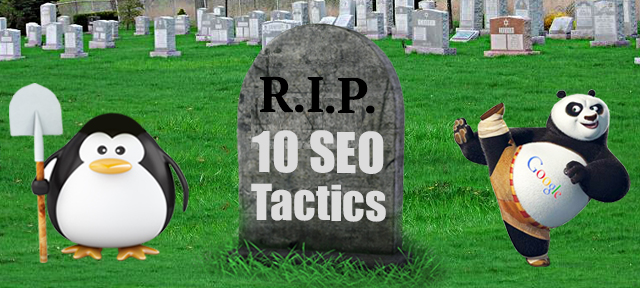Here’s how we expect SEO to change in the year ahead. We hope this knowledge will help you stay ahead of the competition and find your corner of the market.
1. Gray-Hat Won’t Cut It Anymore
Gray-hat SEO walks the fine line between spam and Google’s webmaster guidelines. Gray-hats don’t use automated link building techniques and typically don’t buy links (there’s some debate on this).
However, a gray hat will engage in many link building techniques that aren’t justifiable as marketing separate from the search engines. For example, they’ll build links from obscure websites that are rarely visited and have little chance of growing. They’ll build links from directories that nobody uses. They’ll fill their sites and guest posts with content about a keyword, instead of content meant to be helpful for users. And so on.
The Penguin and Panda updates have already robbed gray-hat tactics of much of their value, and we expect this trend to continue. While it will likely still be possible to rank using gray-hat tactics, you will struggle more frequently, lose past results, and play catch-up quite often.
Focus on SEO tactics that have direct benefits which aren’t directly related to rankings and search traffic. Link building efforts should also be brand building efforts, and SEO campaigns should be designed so that they are profitable even in the absence of search engine benefit.
2. Website Structure, UI, and UX Will Be Primary Ranking Factors
We don’t expect these factors to overtake links as a ranking factor, but we do expect them to have an increasingly notable impact on your search traffic.
Why would Google care? Searchers think of the search results as part of the Google experience. If sites rank well with poor UI and UX, users think Google has a poor UI and UX. That’s bad branding for Google.
3. Bounce Rate and Loading Time Will Matter
It’s already been over two years since Google announced that loading time was a ranking factor, and we expect more emphasis on it this year, especially for one particular reason: mobile. The number of people who access the web from their mobile device is now nearly half the number who access from PC. Most people who access the web from their mobile device have a comparatively slow connection, meaning loading time is more noticeable.
Users tend to bounce off of a site if it doesn’t load within seconds. Eighty percent of users expect a web page to load within 5 seconds, and 60 percent expect it to load in just 3 seconds. Google has incentives to devalue these pages when there are other relevant alternatives.
Speaking of bouncing off a site, we also expect bounce rate to factor into the rankings. Yes, we know, when Danny Sullivan asked Matt Cutts about bounce rate, he appeared to say that they don’t use it. However, Matt Cutts’ answer was actually a bit evasive:
“Webspam doesn’t use Google Analytics. I asked again before this conference and was told, No, Google does not use analytics in its rankings.”
We never suspected Google was using Analytics to rank pages, at least not directly. But we arecertain Google is tracking user behavior through its search engine. How else could Google Suggest work?
We are confident that Google can and will track bounce rate by measuring when users return to the SERP. If they return to the SERP and click on a different search result, this could indicate that they didn’t find what they were looking for from the page. This is what we mean when we say that bounce rate will become a primary ranking factor.
4. Content that Solves no Problem for Users Will Rarely Rank
With all the machine learning and surveys being done at Google, they will only get better at spotting useless content. We expect this type of content to rank only in cases where there is simply no other option, where there are literally only low quality results for the topic in question.
This is especially true for topics that have a social component. Social sharing has become an activity that far more people are involved in compared to link building. The search engines can’t ignore these signals, and if there is an on topic page with social metrics, it is most likely going to outrank a page without the social networks by the end of this year.
We’re not claiming that social metrics will become more important than links. We are simply stating that they will be a necessary component in all but the most stale topics on the web.
5. Who Shares Will Matter
Perhaps more important than a growing emphasis on social metrics, we expect power influencers to have more impact on the search results. If Rand tweets something or shares it in Google+, this will have more influence on search results than if a brand new profile or somebody with few followers shares the same page.
6. Google Will Be Even More Strict About Link Manipulation
We almost feel like we shouldn’t even have to say it at this point, but links from link directories, article directories, forums, blog comments, low quality guest posts, social bookmarking sites, and so on will be essentially useless by the end of 2013. These types of links won’t likely get you penalized, but they will pass very little value and do nothing for your long term rankings.
7. Authorship Will Influence Rankings
Authorship will allow Google to follow a single writer across all the properties that they have contributed to. By tracking the results of each piece of content, the search engine will be able to issue a score to each writer. This will be factored into Google’s quality score for each page, which will in turn have an impact on rankings. Authorship will also play a part in which social shares matter the most, since influencers will tend to have a higher author rank.
8. Content Marketing and Social Media Optimization Will Be Key Ingredients
While it’s not easy or successful in the long term, it’s still possible for sites to rank without genuine content marketing or a social media strategy. We don’t expect this to remain true by the end of the year.
We expect the search engine to increasingly filter out the influence of low quality sites. There will be a threshold of quality. Sites that have no links from sites below this threshold will simply not rank for anything competitive.
The same will be true for social media. Sites that have little or no social activity associated with them will fail to turn up in the search results for any competitive search term.
None of this is to say that sites without content marketing and social media will never turn up in the search results. We just don’t expect them to show up in cases where relevant pages that dohave content marketing and social metrics exist.
9. Co-Citations Will Replace Anchor Text
Anchor text is simply too easy to manipulate, and Google no longer has any reason to use it as an important ranking signal. Google will instead look for correlations between brand names and keyword phrases. It will pull this information from search queries and it’s massive database of crawled pages throughout the web. Similar factors, like the proximity of keywords to links, as well as their synonyms, will also play a part.
10. Pinterest Will See Continued Growth
This social photo sharing site lost a bit of steam in the second half of 2012. Pinterest will most likely go through some re-branding in an effort to expand it’s audience beyond the rural homemakers that helped build the network, allowing Pinterest to break into a more mainstream market. This will reduce the click through rate a bit, but the overall referral numbers will get higher as traffic grows on the site. We expect it to be hard to ignore Pinterest as a marketing channel in 2013, although not necessarily impossible.
Conclusion
For those who have become accustomed to sub-part marketing techniques, 2013 is going to be a difficult year. We expect to see some players leave the industry in search of other short-term strategies.
For those who stick around, the focus is going to shift toward brand building and profitability even in the absence of rankings. This is going to make it a tougher industry to work in, but a more lucrative one as well. As online activity continues to grow in the US and the world, more opportunities will open up and we’ll see our earning potentials grow.
That’s our take on things. Where do you think things are headed in 2013? Let us know in the comments, and pass this along if you liked what we had to say.

















